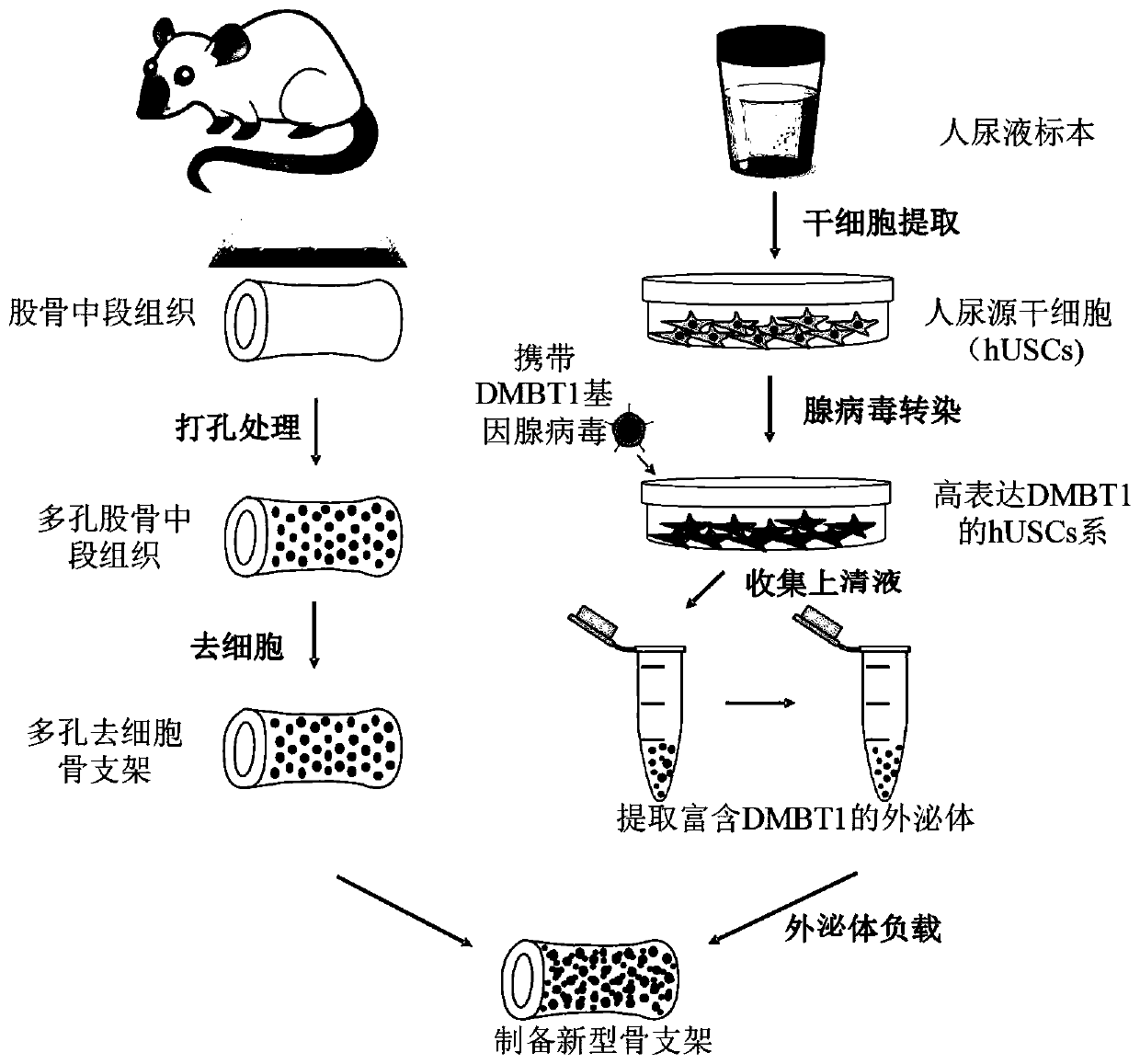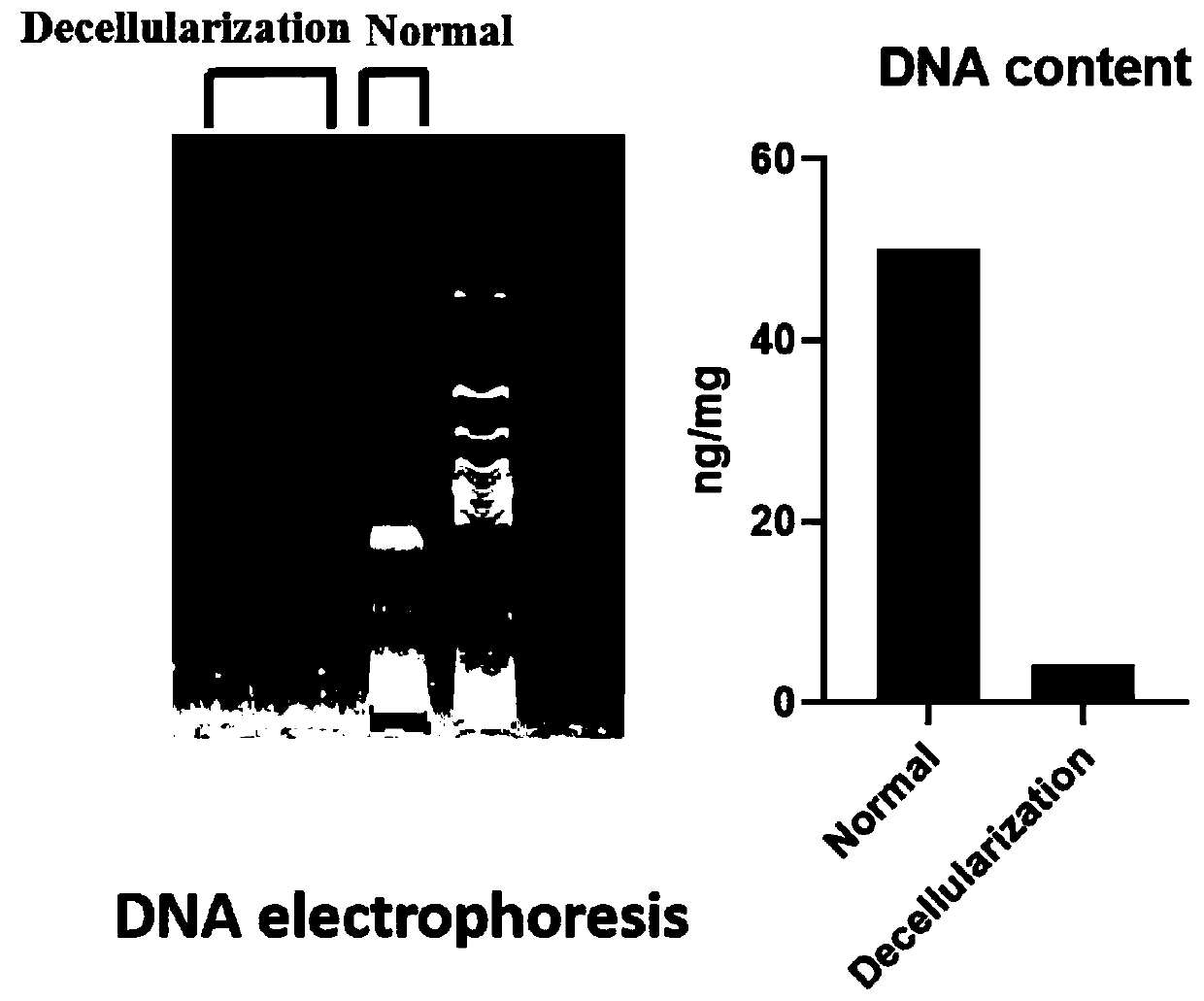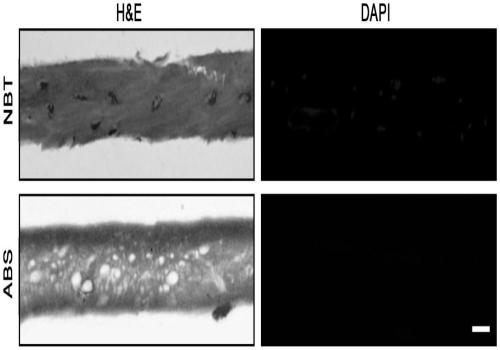Novel bone tissue engineering scaffold and preparation method thereof
A bone tissue engineering and tissue technology, applied in the field of biomedical tissue engineering, can solve the problems of expensive preservation, cumbersome operation process, difficult preservation, etc., achieve good biomechanical properties, reduce immune rejection, and maintain the effect of roughly morphological structure
- Summary
- Abstract
- Description
- Claims
- Application Information
AI Technical Summary
Problems solved by technology
Method used
Image
Examples
Embodiment 1
[0103] Example 1 Preparation and evaluation of decellularized porous femur
[0104] 1. Porous femur tissue acquisition
[0105] After euthanasia of adult (12-week-old) SD rats, the middle section of the right femur was collected, trimmed to a length of 10 mm, washed with 1% double-antibody PBS solution to remove bone marrow and blood, and punched with a device (for the device, refer to patent application CN201520084830. 7) Drill holes in the segment of bone tissue, and decalcify with 10% EDTA buffer solution for 15 days.
[0106] Wherein the aperture of the hole of the femur tissue obtained after punching is 100 μm on average, the hole depth is about 1mm, the spacing of the holes is 0.5mm on average, and the porosity of the bone material is 50%.
[0107] 2. Decellularization of porous femoral tissue
[0108] The porous femoral tissue was placed in a PBS solution containing 0.1% (w / v) SDS+0.1% (v / v) Triton X-100, shaken slowly at 4°C for 24 hours, and rinsed with 1% (w / v) dou...
Embodiment 2
[0116] The preparation of embodiment 2 novel support
[0117] 1. Isolation and culture of human urinary stem cells (hUS Cs)
[0118] Collect 200 mL of sterile fresh middle urine from 3 healthy adults, add 5 mL of penicillin and streptomycin to mix, divide into 4 tubes of 50 mL centrifuge tubes, centrifuge at 400 rpm for 10 min, discard the supernatant, add 20 mL of PBS solution, blow and mix, Continue to centrifuge at 400 rpm for 10 min, discard the supernatant, resuspend the hUSCs medium and inoculate them on 0.1% gelatin-coated 6-well plates, and culture them statically in a 37°C, 5% CO2 incubator. hUSCs medium components: DMEM / F12, 2% fetal bovine serum, 10ng / ml epidermal growth factor (EGF), 2ng / ml platelet-derived growth factor (PDGF), 1ng / ml transforming growth factor (TGF), 2ng / ml ml recombinant human fibroblast growth factor (hFGF), 0.5 mmol / L hydrocortisone, 24 mg / ml insulin, 20 mg / mL transferrin, 549 ng / mL epinephrine, 125 ng / mL triiodothyronine. After the primary ...
Embodiment 3
[0131] Example 3 In vivo evaluation of decellularized bone scaffolds
[0132] 1. Establishment of SD rat femoral shaft defect model establishment and surgical treatment
[0133] Adult male SD rats were taken, and after satisfactory intraperitoneal anesthesia with 0.3% pentobarbital sodium, the hair on the right lower limb was removed, disinfected with povidone iodine, and sterile towels and hole towels were spread. A minimally invasive longitudinal incision was made on the lateral side of the femur to expose the femoral shaft, and the bone tissue with a length of 0.8 cm was removed with a small animal pendulum saw. Then, select the lateral patellar incision of the right knee joint to incise the skin, separate it layer by layer, expose the femoral condyle, use an electric drill to drill a 2.0mm Kirschner wire retrogradely into the femoral medullary cavity through the intercondylar fossa of the femur, and penetrate the skin of the greater trochanter of the femur proximally. The...
PUM
| Property | Measurement | Unit |
|---|---|---|
| pore size | aaaaa | aaaaa |
| pore size | aaaaa | aaaaa |
| pore size | aaaaa | aaaaa |
Abstract
Description
Claims
Application Information
 Login to View More
Login to View More - R&D
- Intellectual Property
- Life Sciences
- Materials
- Tech Scout
- Unparalleled Data Quality
- Higher Quality Content
- 60% Fewer Hallucinations
Browse by: Latest US Patents, China's latest patents, Technical Efficacy Thesaurus, Application Domain, Technology Topic, Popular Technical Reports.
© 2025 PatSnap. All rights reserved.Legal|Privacy policy|Modern Slavery Act Transparency Statement|Sitemap|About US| Contact US: help@patsnap.com



